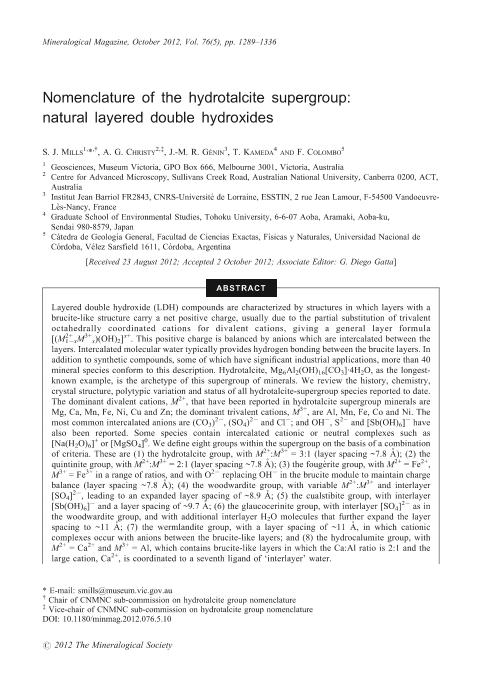Mostrar el registro sencillo del ítem
dc.contributor.author
Mills, S.J.
dc.contributor.author
Christy, A.G.
dc.contributor.author
Génin, J. M. R.
dc.contributor.author
Kameda, T.
dc.contributor.author
Colombo, Fernando

dc.date.available
2018-07-16T18:20:24Z
dc.date.issued
2012-10
dc.identifier.citation
Mills, S.J.; Christy, A.G.; Génin, J. M. R.; Kameda, T.; Colombo, Fernando; Nomenclature of the hydrotalcite supergroup: Natural layered double hydroxides; Mineralogical Soc; Mineralogical Magazine; 76; 5; 10-2012; 1289-1336
dc.identifier.issn
0026-461X
dc.identifier.uri
http://hdl.handle.net/11336/52236
dc.description.abstract
Layered double hydroxide (LDH) compounds are characterized by structures in which layers with a brucite-like structure carry a net positive charge, usually due to the partial substitution of trivalent octahedrally coordinated cations for divalent cations, giving a general layer formula [( M 2+ 1-x M 3+ x )(OH)2] x +. This positive charge is balanced by anions which are intercalated between the layers. Intercalated molecular water typically provides hydrogen bonding between the brucite layers. In addition to synthetic compounds, some of which have significant industrial applications, more than 40 mineral species conform to this description. Hydrotalcite, Mg6Al2(OH) 16[CO3]•4H2O, as the longest-known example, is the archetype of this supergroup of minerals. We review the history, chemistry, crystal structure, polytypic variation and status of all hydrotalcite-supergroup species reported to date. The dominant divalent cations, M 2+, that have been reported in hydrotalcite supergroup minerals are Mg, Ca, Mn, Fe, Ni, Cu and Zn; the dominant trivalent cations, M 3+, are Al, Mn, Fe, Co and Ni. The most common intercalated anions are (CO3)2-, (SO4)2- and Cl -; and OH-, S2- and [Sb(OH)6] - have also been reported. Some species contain intercalated cationic or neutral complexes such as [Na(H2O)6]+ or [MgSO4]0. We define eight groups within the supergroup on the basis of a combination of criteria. These are (1) the hydrotalcite group, with M 2+:M 3+ = 3:1 (layer spacing ∼7.8 Å); (2) the quintinite group, with M 2+:M 3+ = 2:1 (layer spacing ∼7.8 Å); (3) the fougèrite group, with M 2+ = Fe2+, M 3+ = Fe3+ in a range of ratios, and with O2- replacing OH- in the brucite module to maintain charge balance (layer spacing ∼7.8 Å); (4) the woodwardite group, with variable M 2+:M 3+ and interlayer [SO4] 2-, leading to an expanded layer spacing of ∼8.9 Å; (5) the cualstibite group, with interlayer [Sb(OH)6]- and a layer spacing of ∼9.7 Å; (6) the glaucocerinite group, with interlayer [SO4]2- as in the woodwardite group, and with additional interlayer H2O molecules that further expand the layer spacing to ∼11 Å; (7) the wermlandite group, with a layer spacing of ∼11 Å, in which cationic complexes occur with anions between the brucite-like layers; and (8) the hydrocalumite group, with M 2+ = Ca2+ and M 3+ = Al, which contains brucite-like layers in which the Ca:Al ratio is 2:1 and the large cation, Ca2+, is coordinated to a seventh ligand of 'interlayer' water. The principal mineral status changes are as follows. (1) The names manasseite, sjögrenite and barbertonite are discredited; these minerals are the 2H polytypes of hydrotalcite, pyroaurite and stichtite, respectively. Cyanophyllite is discredited as it is the 1M polytype of cualstibite. (2) The mineral formerly described as fougèrite has been found to be an intimate intergrowth of two phases with distinct Fe 2+:Fe3+ ratios. The phase with Fe2+:Fe 3+ = 2:1 retains the name fougèrite; that with Fe 2+:Fe3+ = 1:2 is defined as the new species trébeurdenite. (3) The new minerals omsite (IMA2012-025), Ni 2Fe3+(OH)6[Sb(OH)6], and mössbauerite (IMA2012-049), Fe3+ 6O 4(OH)8[CO3]•3H2O, which are both in the hydrotalcite supergroup are included in the discussion. (4) Jamborite, carrboydite, zincaluminite, motukoreaite, natroglaucocerinite, brugnatellite and muskoxite are identified as questionable species which need further investigation in order to verify their structure and composition. (5) The ranges of compositions currently ascribed to motukoreaite and muskoxite may each represent more than one species. The same applies to the approved species hydrowoodwardite and hydrocalumite. (6) Several unnamed minerals have been reported which are likely to represent additional species within the supergroup. This report has been approved by the Commission on New Minerals, Nomenclature and Classification (CNMNC) of the International Mineralogical Association, voting proposal 12-B. We also propose a compact notation for identifying synthetic LDH phases, for use by chemists as a preferred alternative to the current widespread misuse of mineral names. © 2012 Mineralogical Society.
dc.format
application/pdf
dc.language.iso
eng
dc.publisher
Mineralogical Soc

dc.rights
info:eu-repo/semantics/openAccess
dc.rights.uri
https://creativecommons.org/licenses/by-nc-sa/2.5/ar/
dc.subject
Barbertonite
dc.subject
Brucite
dc.subject
Cyanophyllite
dc.subject
Hydrotalcite
dc.subject
Hydrotalcite Supergroup
dc.subject
Layered Double Hydroxide
dc.subject
Ldh
dc.subject
Manasseite
dc.subject
Nomenclature
dc.subject.classification
Meteorología y Ciencias Atmosféricas

dc.subject.classification
Ciencias de la Tierra y relacionadas con el Medio Ambiente

dc.subject.classification
CIENCIAS NATURALES Y EXACTAS

dc.title
Nomenclature of the hydrotalcite supergroup: Natural layered double hydroxides
dc.type
info:eu-repo/semantics/article
dc.type
info:ar-repo/semantics/artículo
dc.type
info:eu-repo/semantics/publishedVersion
dc.date.updated
2018-07-11T17:45:44Z
dc.journal.volume
76
dc.journal.number
5
dc.journal.pagination
1289-1336
dc.journal.pais
Reino Unido

dc.journal.ciudad
Middlesex
dc.description.fil
Fil: Mills, S.J.. Museum Victoria; Australia
dc.description.fil
Fil: Christy, A.G.. Australian National University. Centre for Advanced Microscopy; Australia
dc.description.fil
Fil: Génin, J. M. R.. CNRS-Université de Lorraine; Francia
dc.description.fil
Fil: Kameda, T.. Tohoku University. Graduate School of Environmental Studies; Japón
dc.description.fil
Fil: Colombo, Fernando. Consejo Nacional de Investigaciones Científicas y Técnicas. Centro Científico Tecnológico Conicet - Córdoba. Centro de Investigaciones en Ciencias de la Tierra. Universidad Nacional de Córdoba. Facultad de Ciencias Exactas Físicas y Naturales. Centro de Investigaciones en Ciencias de la Tierra; Argentina
dc.journal.title
Mineralogical Magazine

dc.relation.alternativeid
info:eu-repo/semantics/altIdentifier/url/https://pubs.geoscienceworld.org/minmag/article/76/5/1289/85510/nomenclature-of-the-hydrotalcite-supergroup
dc.relation.alternativeid
info:eu-repo/semantics/altIdentifier/doi/http://dx.doi.org/10.1180/minmag.2012.076.5.10
Archivos asociados
